Dune (previously known as just Dune Analytics) earned its unicorn status just three short years after its launch. The data platform helps users query, extract, and visualize large amounts of blockchain data. Here’s everything you need to know about Dune and how it works in 2025.
KEY TAKEAWAYS
➤ Dune (previously Dune Analytics) is a free web3 platform that allows users to analyze blockchain data.
➤ The platform extracts data across Ethereum, xDai, Polygon, Optimism, BSC and Solana chains.
➤ Dune’s open dashboards make it easy to understand and visualize complex data with simple graphs and charts.
What is Dune?
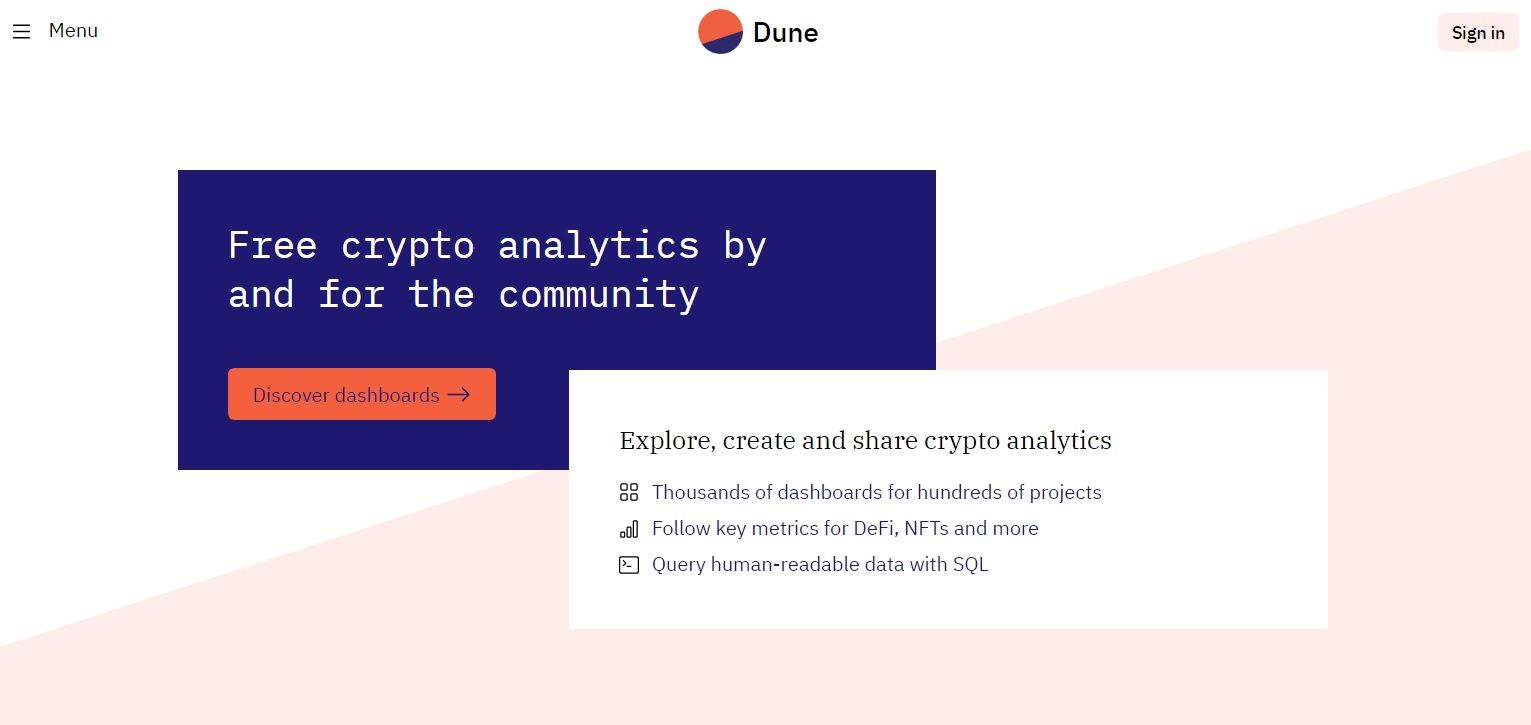
Dune is a leading web3 data platform. Analysts and investors use Dune to research projects such as NFTs, DeFi platforms, or blockchain ecosystems. Anyone can query the data and create visualizations using Dune.
SponsoredThe platform currently supports data across multiple blockchains and layer-2’s including Ethereum, Polygon, Optimism, Binance Smart Chain (BSC) and Solana.
Dune was created to help make web3 data available to all. Anyone can publish and gain access to crypto trends in real-time. The community-based open-source data provider is freely available, so anyone can access and publish data without registering or paying.
Dune makes on-chain crypto data available and consumable. The project’s initial aim was to build a tool that allowed anyone with an internet connection to analyze smart contracts.
Team and funding
Founded in 2018, Dune was launched in 2019 in Oslo, Norway, by Fredrik Haga and Mats Olsen.
In Aug. 2020, the team raised $2 million during in a seed funding round. The platform became popular among those who were able to achieve significant percentage yields using experimental finance protocols in 2020.
In Nov. 2021, Dune raised $8 million in a Series A funding round, followed by $69.4M in a Series B round in 2022, which led to it acquiring unicorn status with a $1 billion valuation.
What makes Dune unique?
Dune is a community-driven initiative. The data can be re-used and is available to anyone. Unlike other companies, the platform doesn’t offer data sets for specific projects. Instead, anyone can query complex data, making use of the free tools on offer.
Dune’s lively community includes traders, analysts, enthusiasts, and others who share their data analysis with everyone. The data is reusable and mixed to suit any user’s needs. As such, it is sometimes referred to as the GitHub for blockchain data analytics.
The platform’s open dashboards make it easy to understand and visualize complex data with simple graphs and charts.
The dashboards you generate with Dune are free to post anywhere on the web, including on your personal website, and can be used for your own data sets. And most importantly, anyone can use the Dune platform for free.
Did you know? The service’s name, Dune, comes from the fact that their data charts look like dunes, and it is also related to Frank Herbert’s science fiction novel, Dune. The platform rebranded from Dune to just Dune in 2022.
How do you use Dune?
Anyone can use Dune by creating an account and using any of the popular Dashboards on the Discover tab. You see these dashboards under the “Discover” tab, and you can search for data using the search bar. You can search for the name of the protocol, token, or even the username who created the dashboard.
Data is displayed in lists or visualized into graphs and bar charts. If you can’t find a query you want, you can create one. However, there are some limitations as to what you can find.
The dashboard
To view any of the listed dashboards, you need to click on the dashboard to view it. Dune does not store any blockchain state data. It only displays the Structured Query Language query results that were requested the last time Dune was accessed.
You can get more info by hovering over the charts. All queries automatically update when you view them. Note that refreshing can take some time, and you’ll be added to a queue. Your data may be out of date by as little as a few minutes to hours.
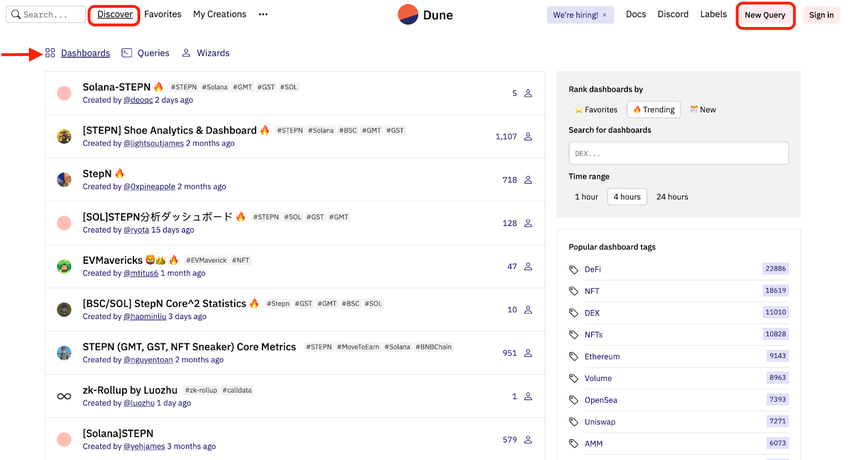
Although most of the features offered by Dune are free, it also offers a paid subscription.
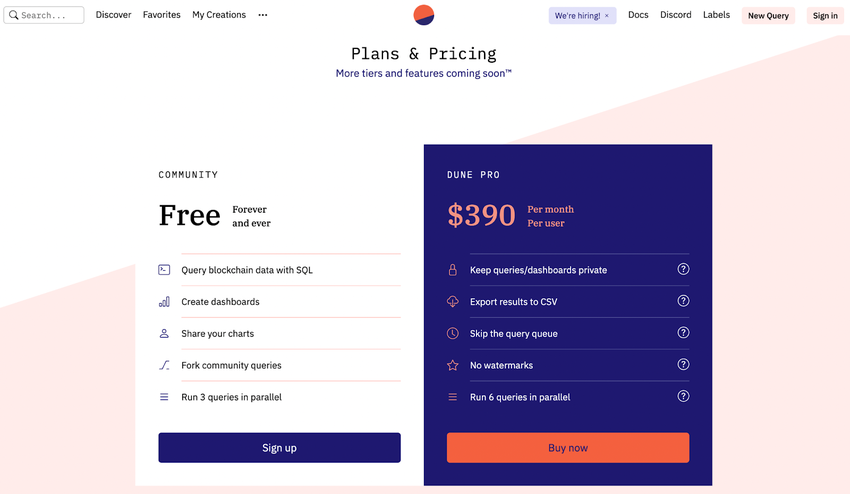
The Dune Pro subscription costs $390 per month, per user. Premium users can skip the query queue to run parallel queries. Dashboards and queries are kept private, and data is exported to CSV files.
SponsoredWriting new queries and creating dashboards
If you wish, you can create your own SQL queries on the Dune platform. To create a new query, you can do so by clicking on “New Query.” Note that you will need to create a free account on the Dune platform to enable new query creation.
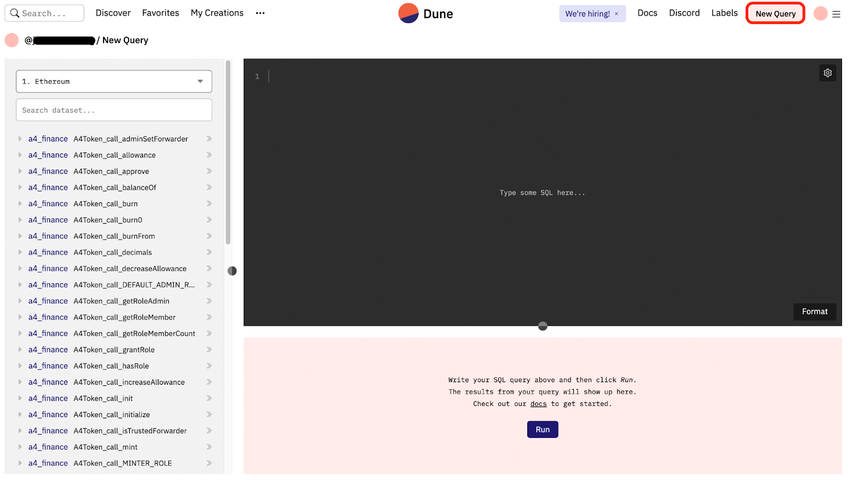
Firstly, you have to select the database for your query (Ethereum, Gnosis Chain, Polygon, Optimism OBM 1.0, Optimism OVM 2.0, BNB Smart Chain, and Dune Engine V2).
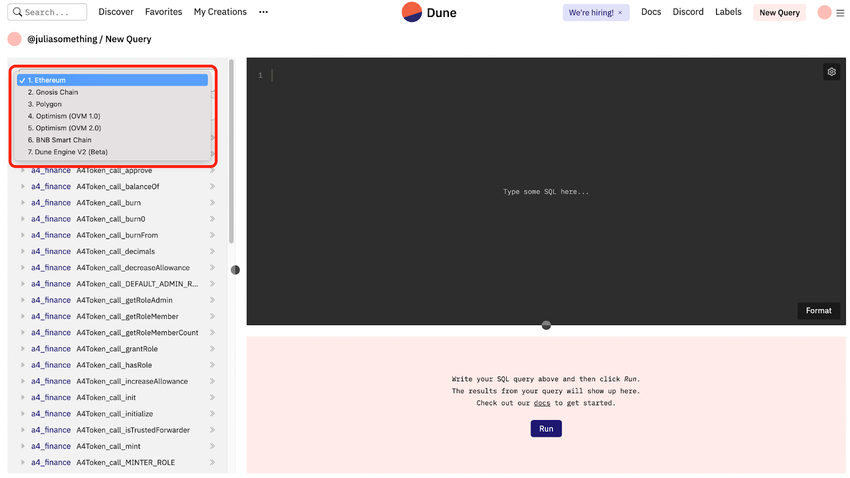
Dune Index (Metrics section)
Dune’s “Metrics,” functionality centers the Dune Index. The index, launched in November 2024, aims to provide a more accurate view of blockchain adoption.
The Index measures adoption by normalizing transaction fees, transfer volumes, and the number of transactions. It moves beyond traditional metrics like active addresses or total value locked (TVL), which can be misleading. For instance, active addresses don’t account for users with multiple wallets, and large holders can inflate TVL without reflecting actual usage.
The Dune Index combines transaction fees (45% weight), USD transfer volume (45%), and transaction count (10%), standardized against a 2018 baseline.
You can analyze blockchain adoption trends through specific data categories:
- Transaction fees, which tracks USD spent on gas fees.
- Transfer volume, which measures net USD value moved on-chain, filtering speculative transfers.
- Transaction count, which captures genuine transactional activity across blockchains.
The Index applies strict filtering methods to ensure accuracy:
Sponsored Sponsored➤ Transfer volume calculation: The index tracks net transfers per address per day to prevent artificial inflation. This method excludes repeated intraday movements that do not change an address’s overall balance. Additionally, transfers between addresses belonging to the same owner, such as centralized exchanges, are netted together.
➤ Transaction threshold: Only transactions involving at least $1 are counted. This prevents excessive noise from micro-transactions while maintaining a broad dataset that reflects meaningful adoption trends.
As of Jan. 29, 2025, the Index stands at 89, with Solana, Ethereum, and Bitcoin contributing the most to overall blockchain adoption.
➤ In short, the Dune Index helps developers, investors, and analysts track meaningful blockchain growth beyond mere price speculation.
Using Dune for NFTs
Dune is a great platform that can be very useful for crypto companies and anyone looking for blockchain data because it allows anyone to query, extract, and visualize tons of data from the blockchain.
It is a powerful tool that anyone who loves to work with data needs to perform analysis for NFTs. You will find many OpenSea dashboards on the platform.
Here are some examples of the most popular NFT dashboards:
- OpenSea Top Trader Stats by @mtitus6 (Top Traders – Recent Purchases, OpenSea – Top 50 Traders)
- NFT Sales Data OpenSea by @cryptuschrist (Volume, Sales, and Median Price, Top NFT Collections by Volume)
- OpenSea Data @pancakephd (Active Users, NFTs Sold, Volume, OpenSea Volume Per Use)
- NFT Market Overview by @sealaunch (OpenSea Volume and Transactions, Trending NFT Projects, NFT Market Volume per Day on Ethereum)
Dune offers a clear view into the market
While on-chain data may not be able to help with trading or observing short-term trends, tools such as Dune can be key for uncovering macro trends. For example, data pulled from Dune can give you a feel for whether the market is leaning towards a bear or bull market, or give answers regarding volumes and shifts in trends. Knowledge is power, and as the saying goes, “data is the new gold”. Tools like Dune ensure this crucial information is accessible and easy to understand even for beginners.

